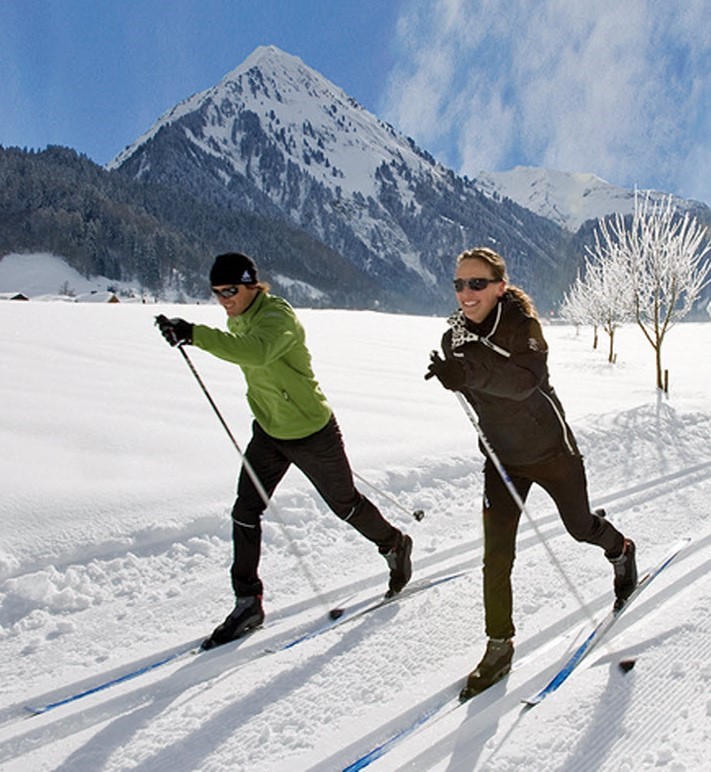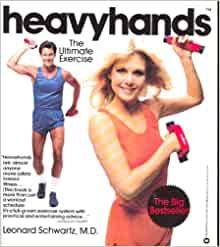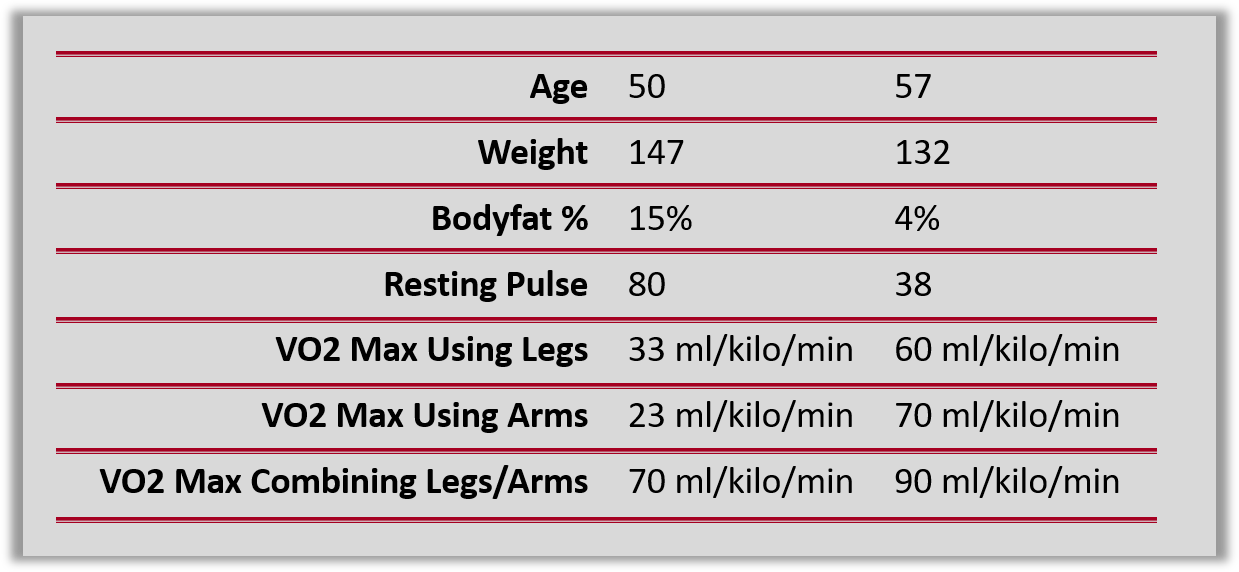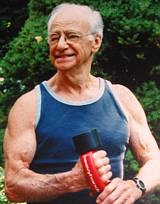Leonard Schwartz was a medical doctor, psychiatrist, exercise researcher and inventor of Heavyhands. We have all seen joggers running along carrying little red hand weights. Those are Heavyhands and Len Schwartz invented these devices as adjuncts to his unique cardiovascular exercise system.
If you were to watch the Heavyhand jogger, invariably they use the hand weighs incorrectly. The hand weighs weren’t meant to be Carry Hands, the hand weights were meant to be raised to different levels on each and every stride stroke. The hand weights have behind them a system that is both radical and revolutionary. Len became interested in cardiovascular exercise in his fifties. An overweight smoker with high blood pressure and chronic back problems, Dr. Len was decidedly unfit and decided to do something about his own health and fitness. He became a jogger and found that wanting. He then immersed himself in various fitness theories and strategies of the day and came away decidedly unimpressed. Being a medical doctor, he began accessing available research.
One day the proverbial light bulb went off over his head as he was investigating athletic VO2 maximums. The highest VO2 maximums ever recorded by a group of athletes were not registered by endurance runners, which is what he had logically presupposed before his investigations, but rather by Russian and Norwegian cross-country skiers. Why was this? He wondered. It didn’t take long for him to come up with the answer: the skiers generated propulsion using all four limbs. The runners used only their legs.

The cross-country skiers were registering Maximal Oxygen Consumption rates, per kilogram of bodyweight per minute, of 94. The long distance runners were topping out at 85. Rowers cam in at 75, bicyclists at 70 and speed skaters 65. Everyone registered substantially below the skiers. The skiers propelled their bodies across the landscape using the legs and the arms on every single stride. While the majority of the aerobic world used two limbs, the legs, in their respective modes, the skiers were using four limbs to power locomotion. A cursory examination of the other sports and cardio activities revealed that most disciplines required only two limbs to generate propulsive movement.
fitness porn stars teen tube where to buy testosterone online the municipality of livorno has been awarded state funding of over 168 thousand euros for the project play and fitness areas inclusive
Len wondered how he could recreate the quad-limb exercise form and reap the amazing cardiovascular benefits and endurance capacity of a cross-country skier. He began experimenting, imitating cross-country skiers “double pole action” by pumping small dumbbells while walking. The aerobic apple fell on the cardio Newton’s head: Len was amazed at the aerobic effect of double-ski poling with dumbbells and soon envisioned a whole series of moves and patterns where he lifted light dumbbells to varying heights while walking, jogging, duck-walking, hopping or squatting.
The key was to force four limbs to “share” the aerobic workload. When legs alone were used to elevate the heart rate, the legs had to work considerably harder to attain, retain and sustain the target heart rate. How much easier it was to hit the same target heart rate when legs and arms were used in conjunction with one another. The athlete could generate an elevated heart rate quicker and maintain it longer when the workload was spread among four limbs.The work didn’t seem as hard. While it might take considerable physical effort to reach a heart rate of 150 beats per minute running, it took far less effort to achieve the same heart rate jogging while simultaneously pumping light hand weights.
Len took his suspicions and suppositions to the University of Pittsburg sport laboratory where he was able to confirm scientifically everything he had suspected intellectually. He then went into the woodshed and developed a system – using hand weights in a series of freestyle movement patterns that would replicate the huge VO2 maximums that cross-country skiers were attaining. He codified and birthed an entirely new exercise system. This system would be efficient and deliver a multiplicity of results. It would teach Heavyhanders how to use varied movement patterns; these patterns done with certain poundage would have radically different results using increased or decreased poundage. Results would also be impacted by the session duration and frequency. The freestyle movement pattern possibilities were limitless. The poundage possibilities were limitless. A person moving a pair of 20 pound dumbbells short distances for 10 minutes would net far different results than a jogger throwing 2 pound hand weights head high for 60 minutes. Old and young, beginner and elite, fit and unfit, all could tailor custom routines that suited their needs goals, capacity and degree of fitness. The possible combinations were limitless and the advanced user once understood the fundamentals of the system, would be able to devise their own workouts.

Heavyhands required no machine or device that locked the used into a specific pathway. The type of motion used could be altered in every single workout. Sessions could be conducted indoors standing in place, outdoors over sidewalks or trails. You might use a short session with heavy weights, long session with light weights, short motions, exaggerated motions … the endless variety would eliminate boredom and the chance of a repetitive motion injury. Heavyhands could inject a psychological aspect into exercise: Fun! After all, Leonard Schwartz was not only a medical doctor, but also a clinical psychiatrist.
Birth and Death of an Exercise Craze
In 1982 Len published the best book on aerobic exercise every written: Heavyhands, The Ultimate Exercise. He began selling customized Heavyhand weights. These were clever and needed: the handles kept the hand weights from slipping out of the user’s grip, the padding kept seat from messing up the grip and the adjustable weights allowed the user to start off using 1 pound weights and work upwards. For a while Heavyhands was a bona fide exercise craze and swept the country. The problem was subtle: though lots of people bought the hand weights, few read the book.

In order to make the Heavyhand system work, the user needed to raise their arms to varying heights in order to elicit the desired cardio result. Len devised three height levels and the trainee was instructed to achieve a target height with every step. What happened was that people would buy the Heavyhands and carry them around. While Heavyhands was an extremely effective exercise system, Carry Hands was lame and ineffectual. People claimed that they weren’t getting results and the craze petered out – which was too bad because a lot of people really needed what Heavyhands offered. It was a classical case of a very effective system dying because people refused to adhere to the ground rules.
Len’s own transformation was mind-blowing and pointed out how effective the studies use of quad-limbed cardio exercise could be …

No cardio weakling at age 71 I saw Len do 36 pull ups while holding his legs in the V position!
Len Sets Me Straight

I began conversing regularly with Len in the mid-nineties after I had interviewed him for several magazines. His medical background, the fact that he was a psychiatrist and exercise research scientist, gave us much to talk about. And talk we did, for years, several times a week, sometimes for hours. He was fascinated by my “short strength,” my weightlifting and powerlifting prowess. He was genuinely interested in how my tpe of power was developed. In turn I quizzed him like a CIA interrogator working on a Guantanamo Detainee. I had cardio questions galore. He spun my head around. He took me to school and I was a willing student.
My motivation was to determine if athletes who did supplemental cardio training would benefit by substituting Heavyhands for classical aerobic modes. He taught me about oxygen pulse and how pulse accurately represents the effectiveness of heart and skeletal muscle working together in consort. METs (an abbreviation for metabolism) would tell us how much work was being done compared to resting. Oxygen pulse would tell us how efficiently oxygen was being transported at a variety of workloads. Cardiac output was one aspect of oxygen pulse – the other aspect was the rate at which muscles were able to consume oxygen.
“The artery that feeds the muscle contains blood richer in oxygen than the vein that leads the same blood away from that muscle. If you measured arterial and venous blood for their respective oxygen content, you arrive at what is called the A-V Oxygen difference . Pump output and the A-VO2 difference determine oxygen pulse.”
He clued me into Heart-Skeletal Muscle Duets: what, he would ask, limits an individual’s oxygen consumption ability, i.e., is the limiting factor the ability of the heart to deliver oxygen? Or is it the ability of the muscles to receive the oxygen? The answer varies person to person: with some individuals the “senders” – the lungs, heart, blood vessel and blood that feed the muscles – might be inadequate. While for other individuals the “receivers” might be deficient and the capacity of the senders would exceed the capacity of the receivers.
“The elite marathoner runs at approximately 75% of his maximum workload capacity. A Heavyhand user can generate 50% of leg capacity, 50% of arm capacity and exceed the marathon runner’s 75% of maximum capacity using legs only. This is why Heavyhands feels easier. Lots of units, each doing less, add up to more.”
Len pointed out that “First and foremost, Heavyhands is the heart conditioner.” He drew attention to heart rate contractions and the effectiveness of those contractions at pumping oxygen-laden blood throughout the body. He also noted that by placing the arms under stress, measured as per unit of muscle weight and volume, arms can “out do” legs. Arms “have greater training potential; while leg endurance might be upped 10% to 25%, arm endurance can be increased by 100% or more through the use of Heavyhands. Arms are more freer to move than legs and capable of swifter, more complex and less “grooved motion.”
Being a psychiatrist he felt Heavyhand training could even improve intelligence. “The hands enjoy a denser network of connections with our brains than do the feet or legs. Hand work thus feeds into human intelligence more than less imaginative leg work.” Len was the first to alert me that prolonged use of Heavyhands could literally reconfigure muscle tissue, morphing the actual composition of the working muscle by infusing it with additional mitochondria.
The trick to muscle fiber transformation was infusing the cardiovascular activity with an element of resistance.
What if there was a type of strength, long strength, (he called it) that could develop significant power output and sustain this strength output for an extended period?
Would this not, over time, result in the creation of muscle fiber that would have the anaerobic capability of a weightlifter and the aerobic capacity of a long distance runner?
Heavyhands could split the difference. Training in this way can reconfigure existing muscle fiber, creating a new type of muscle fiber. Len Schwartz is a cardiovascular exercise genius by any yardstick or measurement you care to apply. Len devised a positively revolutionary system. It dies an undeserved death brought on by misuse and misunderstanding.
Muscle tissue is muscle tissue. A few minutes daily redirected towards cardio activity would quickly convert their (bodybuilders/powerlifters) muscle enzyme capabilities from ‘one shot’ to sustained performance. And give their hearts a steadied-out ride in the bargain.
– Dr. Len Schwartz
Muscle Fiber Nuts and Bolts
Type I
Type I muscle fibers are slow-oxidative fibers that primarily use cellular respiration. As a result, Type I fibers have (relatively) high endurance. To support their high-oxidative metabolism, these muscle fibers typically have lots of mitochondria and myoglobin. These fibers appear red and are found in muscles of animals that require endurance: chicken leg muscles, the wing muscles of migrating birds would be an example. Long distance runners have leg muscles loaded with Type I fiber.
Type II
Type II muscle fibers primarily use anaerobic metabolism and have (relatively) low endurance. These muscle fibers are typically used during tasks requiring short bursts of strength, such as sprinting or weightlifting. Type II fibers cannot sustain contractions for a significant length of time. In poultry, Type II fibers are white breast meat. There are three sub-classes of type II muscle fiber.

Type III
Type III or “Intermediate fast-twitch fibers” are a cross between Type I and Type IIb. They can utilize both aerobic and anaerobic pathways for energy metabolism. This is the “Hybrid” muscle fiber. To build mitochondria-infused hybrid Type III super muscle, use a blended protocol.
Mitochondria are cellular power plants. They generate most of the cell’s supply of ATP (Adenosine Triphosphate). ATP is used as a source of chemical energy. Resistance training combined with cardiovascular training, causes the composition of muscles to transform. In doing so we can growth limits Nature has imposed up those muscles resetting genetic limits. More nutrients can be processed and mito-infused muscles possess the ability to work harder and longer. Mito-dense muscles are thus able to grow larger and resist fatigue for a far longer period of time.
For more information on different cardio modes including Heavy Hands take a read of our resources below.
Want to learn more about our cardiovascular training philosophy check out our Cardiovascular Training Resource Page. Join the community sign up below to our newsletter and receive our FREE Planning and Periodization Guide. Please feel free to send us a question here or leave a comment below.
Want the inside training scoop?
Join The Community
Our email content is full of value, void of hype, never pushy, and always free. As a BONUS you will receive our FREE planning & periodization template to help you with your training goals.





Marty, such a GREAT article and great details on how to properly use the heavy hands method.
After my knee surgery, I look forward to implementing this into my own life and training.
Thank you, my friend.
Zach,
Thanks for the read! Glad this info resonated with you. Take care.
Brilliant article sir
Thank you for posting
Thank you for this explanation! Just discovered the method, will start today.
You are welcome! Please let us know if you have any questions. Good luck!
In the 90’s i added heavy hands to my weight training, (of 50 years) . which upped my running performance. Since then after a long lapse i shall re include it again. Indeed Heavy Hands was a super discovery by a true thinker.
Richard,
Thank you for sharing your experience with us. Len was a remarkable man. His lessons have stood the test of time.
I used to incorporate handweights in training my racewalk team as well as taught clients in the fitness centers where I was employed on using handweights as they bike on the stationary bicycle. Very impressive results as the entire body was involved in the stress of the exercise, not just the legs.
Thank you Michael for sharing your experience! Len was such a genius. Great to hear about your results. Have a great day!
[…] first sat up and took notice when in 1995 Dr. Len Schwartz began relating to me that he was working on a new type of exercise to develop "Long Strength." […]
[…] fist because it adds an element of muscle tension that spikes the heart rate. It feels like Len Schwartz's Heavyhands without using the hand […]
As a retired guy on a fixed income, the actual Heavy Hands brand gear is pretty pricey, with the adjustable separate weights. I’m looking at a $25 set of D-style 5-pounders with a curved solid wrap around the hands. besides quality, is there any major downside to starting out cheap this way for beneficial similar functionality? I want to further strengthen the muscles supporting my spine with these too, as an addition to the 7-mile brisk walks I take every day. I’ve read Schwartz had back trouble too, and found his method very beneficial for it. Thanks! I’ve also e-mailed my DPT.
Thanks Steven for your question. I think that the D grip dumbbell is a great solution. I had to look it up in Amazon to understand what you were talking about. For anyone reading this comment I have included an Amazon link to dumbbells Steven is describing – https://amzn.to/3j6XSsL. Good luck on your journey!
If the grips are thick, it’s going to be uncomfortable to train with them. You want them to be less than 2 inches in diameter I would think. Many dumbbells have 2 inch handles, which is fine for doing ordinary exercises but not for HHing. I’d go to a sports store to find light dumbbells, no more than 2 lbs, with the skinniest handles available. You can still order them from other places.
What’s the ideal workout schedule for a heavyhands workout? Daily, every other day, 5 days a week for 30 minutes day? I’ve been messing around with the system after recently reading all I can about it. At least 30 “active “ minutes a day according to my fit bit, split between varying levels of intensity from fat burning mode to cardio mode , occasionally touching intense mode. Only been at it about a month and so far I’m thrilled with results! Use alternate 3 and 5 lb neoprene dumbbells and vary my workouts between indoor walking in place while swinging the ‘bells to the 3 levels of height, outdoor walking and swinging or indoor multi movement routines eg. Shadow boxing, stepping, squatting, lunging , presses and curls etc.
Hey Rock,
Thanks for your question. It sounds like you are off to a good start. Without knowing your fitness level its hard to recommend an ideal schedule. We believe in a concept of “creeping incrementalism” where you build fitness over time typically over 12 weeks. By setting weekly goals using a blended average of your heart rate you progressively become more fit. You can then extend frequency (no of times/week), duration (length of session) and intensity (blended session average of your heart rate) over the 12 week cycle. I have added a post discussing how to periodize cardio goals that you may find helpful. This can give you examples of how to preplan your success – https://functional-strength.org/cardio-periodization/ In addition please feel free to send me an e-mail at somg1@comcast.net if you have any additional questions about how to set up a 12 week cycle.
The Heavy Hands protocol can be used all your life in house or outside. I have used it on and off since the early 90s and now at 80 I will,(thanks to another reader here), use the hand weights and exercise bike added to my 5 whole body barbell exercises. Along with prayer this will keep stress at bay a d help us to spell waist without an e but keep that healthy “i”
I used hh off and on since the mid 80s. Got covid 2 yes ago was down a week lost 10lbs. Got on the hh horse doing a variety of moves inside and when weather permitted outside. If you do hh correctly (read dr. Schwartz book) it’s the only w/o program you need
Thanks for sharing your experience with us!
Great Article. I am a 59-year-old male and have been using my own modified weight walking system for over 10 years now. I carry 2 10 pound weights and do a series of 11 exercises (75 curls, 75 overhead, 70 triceps, 35 punches each arm, 35 circles one way 35 circles the other way, 35 arms lifts parallel, 35 triceps with a movement to the outside, 35 lifts crunches above head, 35 stomach side to side and 35 windmills). This is a set and each set takes me approx 11 minutes. I try to do 9 sets per session. So this is 99 minutes or 4.5 miles walking. I will drop the weights after 6 sets and walk further then double back and pick them up for the final 3 sets then walk without any sets just holding the weights til I finish. This allows me to walk longer as I like to walk at least 6-7 miles. I do this 6 days a week. I have never felt better and been in this kind of shape. It has completely changed my fitness level and life. My body composition has also changed for the better. Before I liked to eat and was chunky to say the least. Those days are long gone. I live where I can literally walk out my back door to open space so I take my 3 dogs and we get lost for 2-3 hours every day.
What a great testimonial! Thank you for sharing your training experience with us!